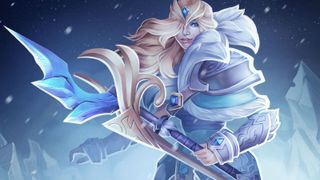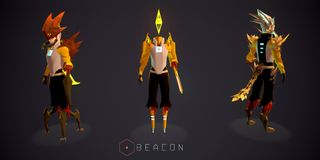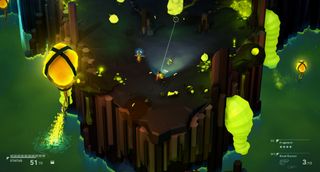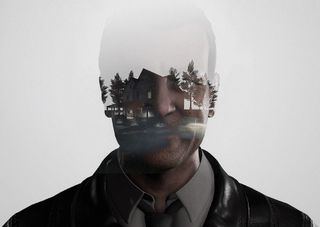
In Beacon, you are what you eat. Or rather, you are what you splice. In this roguelike twin-stick shooter, not only do you pick up weapons and equipment left lying around by the recently deceased, you also harvest their DNA and technology. Back at your pod you splice alien limbs or cybernetic upgrades from your defeated enemies into the next backup clone of the protagonist, freelance space prospector Freja.
Hopefully the resulting cyborg-alien hybrid monstrosity will have more luck than her predecessor—Beacon is a roguelike, so death's likely to come quick—and no opportunity to fret about the continuity of existence when both body and mind can be recreated on a whim.
I had a chance to speak with three of the members of Monothetic, the team working on Beacon. US-based Kiefen Zipf, UK-based Arran Seaton, and Thailand-based Tay Dunn talked about about how this visually striking shooter blended all of their talents and experiences.
PC Gamer: When I first saw Beacon, what immediately struck me was the design aesthetic. What inspired Beacon's look?
Tay Dunn: Primarily cyberpunk, anime, and minimalism. I am a big fan of the illustrators Tomer Hanuka (which is where the vivid color palettes came from), James Jean, and the BLAME! manga series. And lots of architecture design books! My dad studied architecture so I've always had a fondness for the art.
Beacon is an homage to all those comics I enjoyed when I was younger and the sci-fi films and designers that have seared themselves into my visual memory. Akira, Satoshi Kon's work, HR Giger, and Dune came to mind.
...there's some weird combinations you can get in Beacon where you're a half-droid, half-bug monstrosity!
Kiefen Zipf
Arran Seaton: I came from a background in HL2 modding, making levels and entering mapping competitions through my late teens. We initially worked together on a mod called Canvas, a third-person adventure game that had a conceptually interesting Psychonauts/Mario 64 vibe to it. Working on that project led directly into me landing a level design job at Playground Games, where I worked on the first Forza Horizon.
PC Gamer Newsletter
Sign up to get the best content of the week, and great gaming deals, as picked by the editors.
After that I moved to Newcastle to join Ubisoft Reflections and worked on The Crew for nearly two years. During that time I was still staying in touch with the team, helping out with [Half-Life 2 mod] Black Snow and subsequently Haven [a cancelled Monothetic project], before eventually quitting to concentrate on Beacon once we established a more concrete idea of the game.

Kiefen Zipf: We also take a lot of inspiration from classic sci-fi films. A few off of the top of my head are 2001: A Space Odyssey, Starship Troopers, Blade Runner.
For the first few years of development I moonlit as a Dota 2 Workshop artist. I was still living at my parents' and we had just started working on Haven. I figured I could try make a job out of it after I saw a few other artists having success.

Kiefen Zipf designed several item sets for Dota 2 before working on Beacon. His favorite is Charge of the Tundra Warden for Crystal Maiden. (Illustration by Tiffany Boother.)
I had already had a couple of Team Fortress 2 items added in-game, but Dota was a completely different art style and workshop. After about a year of contributing, I actually was able to get some sets in game and was able to move out here to San Francisco to live with Tay and our programmer [Mike Corsaro].
AS: You had some pretty decent success though!
KZ: For the International Dota 2 Championships 2014 and 2015, Valve invited some of the workshop artists to attend and showcase their work at a Workshop Section of The International arena. Both of those years I was invited to hand out and sign prints of my sets to fans. It was a cool experience, both to get invited to the event to watch the games in person and also to get to interact with fans interested in our work. It's always satisfying to see a cosplayer bring something you worked on to life.
How do you apply that experience developing for the Dota 2 Workshop to Beacon?
KZ: Learning to adapt an aesthetic and set of models to a set (helmet, armor, bracers, weapon, etc...) actually translated pretty directly into my work on Beacon. When you die in Beacon, you get the chance to apply DNA you've looted to your next clone, giving you a chance to get mutations. The mutation system in the game has slots set up that let me add a mutation for Freja's head, back, arms, feet, and tail, so making mutation sets in Beacon is a pretty similar process to making a Dota set.
Just how you can have wacky combinations of items in Dota, there's some weird combinations you can get in Beacon where you're a half-droid, half-bug monstrosity!

Tell me a bit more about each of the factions.
TD: The Prism are the main antagonist. They consist of a workforce of automated droids which patrol the planet. The Prism are the lynchpin of Beacon's aesthetic, as it is the first faction being concepted, I took a lot of inspiration from [Neon Genesis] Evangelion and Neill Blomkamp while designing them. They are very angular and hostile looking, yet sleek. Even with decades-old tech, Prism is still ahead of any contemporary technology offered on the public market in the world of Beacon.
The Solus are bugs! Alien bugs! The Solus is the dominant species on the planet before Prism came along. For the Solus I just kinda started doing something vaguely Starship Troopers-y and ended up with what we have now. I've added a lot of softer, curvaceous forms to the Solus architecture and enemies to distinguish them from the droids. My big inspiration actually came from underwater creatures and anemones.

The Native faction represents the indigenous population of the planet that is outside of the Solus ecosystem, so it could be all sorts of things. We actually plan to introduce a few more creepy crawlies in this category. Right now we also have the Chilopods, giant space centipedes that can curl up and roll around like spiky wheels of death, and the Karnak, which are pacifist Nautilus-headed tripods.
Most of the mutations are directly based on of enemies in the game, so whenever a new enemy is added I rip it up and find ways to make the parts "grow" out of Freja.
Kiefen Zipf
The natives don't have a very cohesive design aesthetic, since they're all supposed to be their own little factions in their own right. We have everything from space raptors to a floating gas bag that wobbles around and eats stuff in the background.
[The Uncharted faction] is probably the most fun one. We haven't showed off a lot of these yet. They are basically specimens that Prism have imprisoned in the facility, to either be contained or experimented on. They come from all over the galaxy so they could literally be anything, and we definitely have some wild ones planned.
How do you make odd combinations like that work well together? It seems like it'd be hard to make them adhere to a coherent look.
TD: I usually do concept art for most of the stuff we have going in Beacon so the visual design is still pretty consistent. Right now we're at a point where Kiefen can produce a lot of organic pieces without needing much input from me, since he now understands the aesthetic that we were shooting for. We're in this sort of harmonious balance now, where I do the sci-fi/hard surface stuff, and he does the more organic pieces like the Solus insects or caves, etc.
There is a very clear cut color palette for each faction. For example, Prism is orange, Solus usually bright neon green, Native is subdued brown, etc. Freja and anything friendly or equipment coming from her ship is usually yellow.

A design by Tay Dunn from canceled project Haven. The Monothetic team realized Haven was impractically large and complicated, and canceled it in favor of beginning of development on Beacon.
Freja is also a relic of Haven, which also had a strong female protagonist as the player character. When I designed Freja, I used my love of both Western graphic novels and Japanese manga as a base, and she is somewhere in between. Her look is very mixed, and it is implied she comes from many racial backgrounds: as a homage to her design as well as my vision of the future as being a conglomeration of many cultures, with countries taking a backseat to self-identification.
Her sleeves came from these really cool '80s-esque puffy PVC jackets that I saw in a fashion shoot somewhere that I can't seem to find anymore, and something that echoes Rachel from Blade Runner with those really wide shoulder pads. I wanted something simple and functional yet with a striking aesthetic and landed on this. Her original design had her wearing a helmet that looked like a soccer ball [laughs]. And I guess her haircut is similar to what I have now, although it wasn't like that when I designed her!

KZ: Making distinct mutations within each faction is pretty simple actually. Most of the mutations are directly based on of enemies in the game, so whenever a new enemy is added I rip it up and find ways to make the parts "grow" out of Freja. Each enemy within the faction has its own distinct leg shape or armor color or head, but it still feels like a Solus mutation (the insect faction) or a Prism mutation (the droid faction).
...earlier iterations just have the player arrive into a post-combat wasteland filled with gibs, with the factions killing each other off already.
Tay Dunn
AS: Although each faction and subsequent player mutation adheres to a certain look and specific colour palette, we definitely want and encourage folks to mix and match with all the various types of faction DNA to create wonderful monstrosities. That’s where the benefits of the modular design come from: from a visual and gameplay perspective, we can control how all of those potential combinations intertwine.
We look at what can work in terms of affecting Freja’s silhouette in interesting ways. What parts of the enemies can we use to that make sense for our mutation system and their purpose from a gameplay standpoint. The low-poly aesthetic I think helps homogenize the potentially conflicting looks, but yeah we want to embrace the weird for sure.
TD: Beacon's science is a bit messy, more Aliens or The Fly than Minority Report. It is not sleek, it's kind of tongue-in-cheek, and it can produce some crazy results!
So you have all this backstory for these factions. How is that communicated to the player?
KZ: Everything in the game is tied to the factions. Loot spawns, enemy spawns, DNA and Mutations, the world you're in. The factions are a great way to add randomization as well. One playthrough you might fight your way through a Prism mining outpost and find a cache with a Laser Boomerang, and the next you might fight through a Solus hive and find a Quill Cannon.
TD: The factions were something that was decided quite early on, as we want the player to see and use these warring teams to their own benefit. I've always enjoyed games that have a more dynamic conflict system like this so it feels more alive, and the world doesn't feel like it exists just for the player to come in and fight everything.
Yes, we had to tweak this a little bit even—earlier iterations just have the player arrive into a post-combat wasteland filled with gibs, with the factions killing each other off already. Which is no fun!
Some factions may also ignore each other unless provoked, or some enemies within factions that normally opposes each other may unite for the common goal of escaping the planet and/or hunting the player down.
KZ: Besides nearly all of the factions hating Freja, they all have their own relationships with each other that influence the world in the background. Outside of changing the combat it also changes the world from playthrough to playthrough. While Freja's clones are cycling through the planet over time, different territories will get taken over by different factions. One time you play through a Prism Shipping Fortress it might be completely functioning with conveyors moving shipping containers around, and next playthrough it could be infested by Solus with the conveyors blocked up with containers piling up and spilling out over a cliff.
Most Popular




